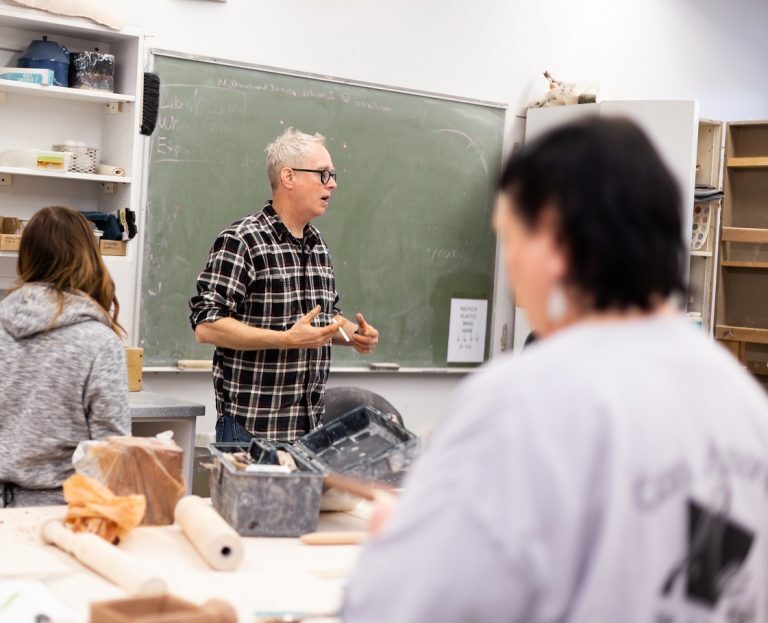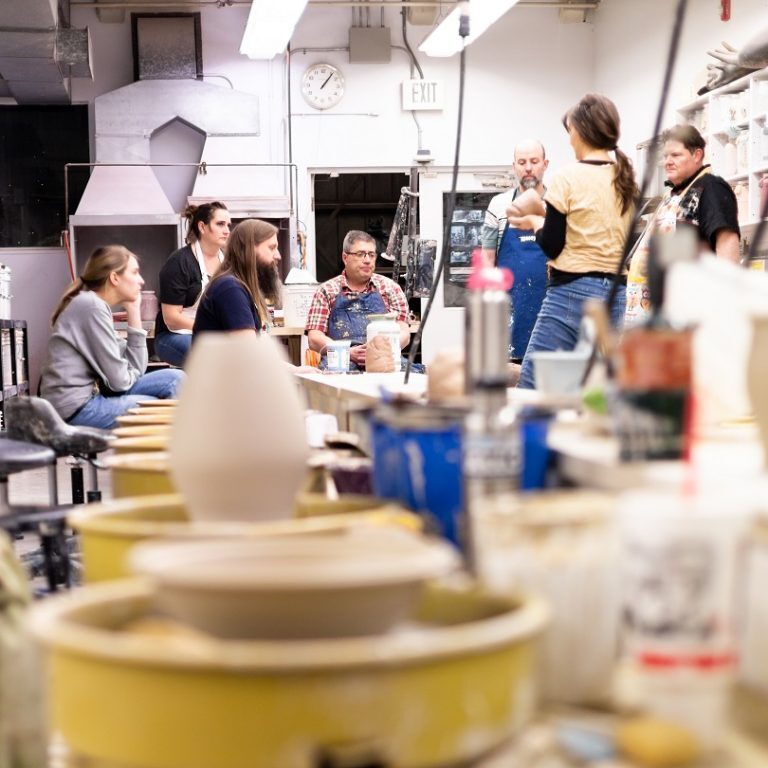The on-campus workshop series resumes in June, with instruction in drawing, intaglio printmaking, mixed media monotyping and screenprinting
At the center of a circle of local art teachers, BYU ceramics studio manager James Robertson sat at a wheel demonstrating how to teach students to form a clay cylinder with uniform thickness — no easy task for first-time ceramicists.
“I ask everyone who is a beginner, ‘what is something you’re really good at?’” said Robertson. “It could be a musical instrument, a sport or even video games. When you started, were you really good? No. But did you spend a lot of time practicing it? That’s what this takes.”
On Feb. 7–8, the Department of Art hosted a two-day ceramics workshop for local high school teachers, the first of a series of workshops and events for art educators. Through demonstrations, presentations and hands-on coaching, workshop participants were able to work with faculty in the Department of Art on skills such as hand molding, sculpting faces and throwing basic forms on a pottery wheel.
The workshop fostered an exchange of knowledge in which local educators and BYU faculty shared how they approach teaching different techniques to their students.

“I loved interacting with lively and vital teachers and artists who have many of the same goals for their students as we have in the Department of Art,” said professor Brian Christensen, coordinator of BYU’s 3D studio area. “Getting your hands in clay and solving problems on the spot in a group of peers is an invigorating and collaborative experience.”
Apart from honing their skills and cultivating connections with the community, these workshops offer local teachers the opportunity to help their students forge a path to a degree in art at BYU.
“There are many misconceptions about having a career in art,” said professor Jen Watson. “While it is difficult to change perceptions, we would like to educate our local and regional high school students about art, about its importance within communities and the fruitful careers that come from majoring in it, especially at BYU.”
Plans for future workshops and events for teachers and students also include tours of department facilities, classroom visits and regional information sessions. In February and March, representatives from the Department of Art will host department information sessions in Arizona and California.
At these events, educators will have the opportunity to ask questions about the Department of Art, the art major, scholarships and even options for non-majors who want to continue making art at BYU.

“We want to inform high school educators in particular about the strengths of our department, and to develop a relationship of trust that will encourage them to recommend BYU’s Department of Art to their best senior students seeking higher education,” said Christensen. “We are getting the word out that BYU admissions has a new emphasis on personal essays, which can be inclusive of some art-inclined students who would not have been as competitive with test scores and GPA as the overwhelming admission criteria.”
Four five-day workshops will be offered in the spring and summer. All workshops will have a reasonable place-holding fee and some material costs, but will otherwise be free of charge. Teachers participants can use the workshops for Utah State Board of Education licensure points. The next workshop in the series, which will take place in the first week of June, will focus on figure drawing, sketchbook development and mono printing. Art professor Fidalis Buehler is developing the workshop with other faculty members.
“The Department of Art wants to engage with local art educators, as they have the potential to impact futures one way or another,” said Watson. “Ultimately, we want to hang out with them, we want to generate enthusiasm about art, creative thinking and careers in art for their students.”
